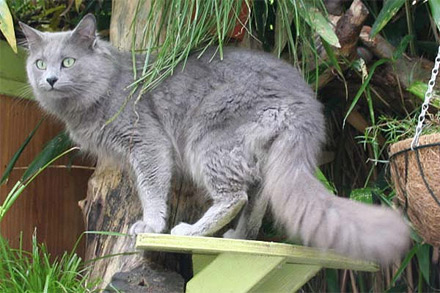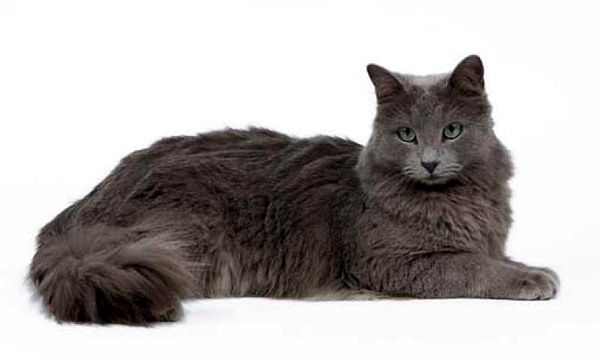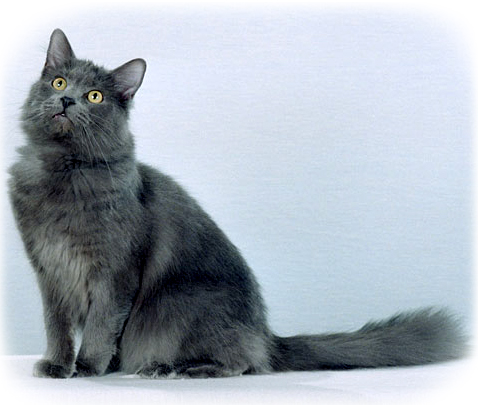- 名称:
- NEB
- 组:
- 半长毛猫
- 类别:
- 基本的
- 起源:
- USA
The origin of the breed

Despite its second name, the “Russian Longhair” has originated in the USA. Although, it is still descending from Russian Blue, and is technically a longhair variation of the abovementioned. Longhair Russian felines are known for like 100 years, yet are only extensively developed since 1980-s. Soon after the fanciers took up the development, by a number of crossings the Balian-like coat composition was achieved, yet it was softer and more tender. Nowadays there are two major strains, the European and American. European strain encompasses natural breeding material, while American one utilises Brunhilda’s Angoran genes and Siegfried's Russian Blue’s. The latter has, actually, defined the name of the breed, Ziegfried (sometimes referred to as Sigurd) - the hero of The Song of Nibelungs. The Nibelungs is the high German for “Children of the fog”, a splendid name for misty felines they are. The owner of Brunnhilde and Siegfried mrs Kora Kobb, the pioneer of the breed’s development, has produced her first litter in 1987. She has consulted geneticists right away to know that kittens in question are longhaired Russian Blues. As a result, the standard for the breed differed from the Russian Blue by coat length only. The breed was nigh immediately acclaimed, with TICA being the first to do so. The WCF and CFF have followed the TICA in 1995, and in 2008 the French felinologists have done the same. Despite being acclaimed by numerous organisations, the breed is still quite rare.
Appearance
An averagely-sized feline, both royal in it’s elegance and stalwart in it’s fitness. It has a peculiar profile and the distinctive faceted head. The main defining feature however, is the amazing coat, soft, cascading, non-clinging and silky to the touch.

Head: Medium sized and shaped as a medium-long wedge, and a rather faceted wedge at that, it ends in a well-defined, pinched muzzle.
Eyes: Large, wide-set, oval and set at a slant. Vivid green colour is desired, although only adult animals grow to have this colour.
Ears: Rather large and wide at base, with slightly rounded tips, they are set upright and are almost hairless.
Neck: Long and thin, it has a fur “collar”, because of which it may appear shorter than it is.
Body: Medium sized, slightly elongated, slim and elegant.
Legs: Of medium length, fit yet slender.
Paws: Narrow and oval, they are elegant and neat.
Tail: Long, fluffy, wide at base and tapering to a round tip, looks and serves as a luxurious, decadent plume.
Coat: Thin and delicate hair makes for an unusually delicate touch, despite having a developed undercoat, it is well clinging and looks silky.
Colours: Guard hair has noticeable silvery tipping - discoloured, slightly reflective spots. Combined with very dense doublecoat it creates an illusion of misty, ghostly halo around the cat. Only blue coat pigmentation is allowed, medium brightness and even tone is desired.
Flaws: Weak chin, non-green eyes.
Disqualification on shows: Spotting and white patches on coat.
Universal disqualification: Amputated claws, cryptorchism, deafness.
Character traits and features

Nibelungs are friendly and level felines, known to be intellectual and witty. They are independent and somewhat reclusive, yet will always favor attention and demand it sometimes. These cats would usually choose a single human as a master, and be wary with others. It treats others pets nicely, and it’s voice is silent and nice. These cats are acute hunters, yet are fine with any housing conditions.
Maintenance and care
Nibelungs truly wonderful coat needs no special attention, while being long enough, it needs no special attention. Nibelung felines should be brushed with a rare-toothed metal comb on a regular basis. Note that the most optimal configuration is the one with rounded tooth, and strokes should align with hair growth direction. When exposed to direct sunlight the coat colour may suffer and burn out, letting way to ginger and brown hues.
Nutrition choices
These feline’s nutritions should consist no iodium or seaweed.
Selection and breeding
Allowed crossings: Russian blue
Breeds relative to or derived from Nebelung: Russian blue
Alternative and obsolete breed names

Russian longhair.
